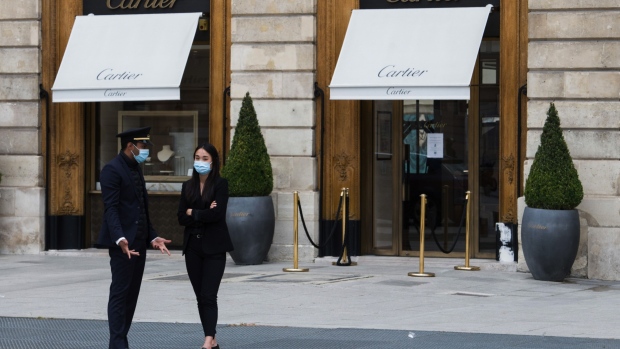Jun 18, 2020
Against luxury headwinds, Cartier bets on the past to protect its future

To appreciate how deeply Marie-Laure Cérède understands the DNA of Cartier SA, the 173-year-old French luxury house where she directs the design and development of timepieces, one must first consider the watch on her wrist and the pen in her hand. The creation team she oversees designed the former — and their first drafts began with the latter.
“Of course, we have the traditional tools of designers and the modern ones — the software and the 3D printer,” Cérède says from her sun-dappled office in Paris’s 8th arrondissement on June 5. “But at first, the Cartier watch is drawn by hand.”
Cérède initially joined the maison in 2002, but she departed in 2005 for Harry Winston. When she came back in October 2016, she adopted the title of deputy director of watchmaking — and was promoted seven months later to her present role, timepieces creation director. She returned at a strong time for the company, but she’s currently overseeing a beleaguered department, as the maison and its hard luxury goods peers face their worst headwind in almost two decades.
Cartier is by far the most powerful brand in the jewelry portfolio of parent company Richemont, representing more than four-fifths of jewelry and over 40 per cent of the luxury conglomerate’s total sales. But Richemont, which did €14.3 billion (US$16.2 billion) in sales last year, saw them plunge 18 per cent in the first three months of 2020 during the pandemic.
For a jewelry house that makes watches, it’s a challenging time but also an opportunity: Jewelry has fared better than other accessories and apparel in part because it’s viewed as an individual long-term investment. Watches, if they’re timeless, can be, too.
“If I can say in one sentence what it means to design a Cartier watch, it’s a signature in a single stroke,” Cérède says, alluding to the soft edges found on the brand’s medley of watch case shapes. You’ll encounter various rounded squares, curvaceous rectangles, slender ovals, and, rarely, a circle. “We used to say that a Cartier designer should put the pen to the paper and not lift it through the curves, only stopping when they’ve achieved the perfect shape.”
Take the swirling bangle on her wrist during our interview, a watch called the Maillon de Cartier. Offset gold links compose its bracelet, forming a woven illusion. Its hexagonal case, measuring only 16 millimeters by 17 millimeters, is set like a jewel. It’s an entirely new model for this spring, designed by Cérède’s watchmaking studio. The Maillon’s glittering facets call to mind the brand’s earliest reputation as the jewelry house of royalty.
Cérède works from the top floor of a 19th century Haussmann building rising between modern glass towers, in an office populated with design objects — a D49 chair by Hans Könecke, a ’50s Ico Parisi desk, and two armchairs by contemporary designer Faye Toogood. Here she sketches, oversees the work of her designers, issues approvals, and digs through reference materials.
Overall, she shepherds a watchmaking venture that began in 1903, as Louis Cartier, grandson of the jewelry maison’s founder, Louis-François Cartier, began work on the Santos. The rounded square was arguably the first watch for men designed to be worn on the wrist, created at the request of an aviator. From 1906’s Tonneau (an oval with flattened ends) to 1917’s Tank (an elegant rectangle), the house introduced shapes the world hadn’t seen before.
Cérède spends substantial time going over these inspirations with the heritage department’s archive team and with the Cartier Collection, the division that reacquires vintage and historic pieces. “Knowledge is a prerequisite to creation, especially for Cartier,” she says. “You need to master the heritage in order to create. We have a look at the historical drawings and their context.”
These aren’t merely sketches of pieces; they’re the stories around them that have been preserved, too, such as the strange tale of the Crash, which dates to 1967. Jean-Jacques Cartier, then head of Cartier London, designed the crumpled-up Crash based on a Cartier watch that had been mangled in a car accident. The result calls to mind the melting clocks of Salvador Dalí.
In her quest for knowledge, Cérède works closely with Pierre Rainero, Cartier’s image, style, and heritage director, whose title requires deciphering. Rainero, who wears a Tank Américaine from the early ’90s and occasionally quotes Voltaire, has been with the brand for more than 30 years. “I was artistic director. It was the end of the ’90s, and I felt very quickly it was wrong as a title,” he says. “The responsibility of the artistic direction is shared by many people. That’s the culture of the house.”
His role involved having “a vision of what the Cartier style should be today and in the years to come.” Cérède benefits from Rainero’s encyclopedic knowledge when overseeing watch reissues, such as 2019’s elongated Tank Cintrée, first released in 1921, and this year’s rhomboid Tank Asymétrique, originally produced in 1936.
No recent collection represents the work of her and her team quite like the Pasha de Cartier, announced in April at Watches & Wonders, an annual trade show primarily for the Richemont brands. (Cartier has been a member since 1993.) Pasha’s storied history began in 1932, when Louis Cartier introduced a round waterproof watch that the brand developed into a collection in 1943. One of the most famous watch designers of all time, Gerald Genta, would reimagine the Pasha de Cartier in 1985 — making it an icon of that decade. The brand reacquired a 1943 model for the Cartier Collection, and Cérède’s team used it as the starting point for this year’s relaunch.
Iterations share similar details: a bold, round case, a square detail on the dial, and an exaggerated cabochon on its crown or crown cover. Pasha wristwatches have been sought by collectors, many of whom have also requested reissues. “We have been dealing with very high expectations from clients for years. We felt this time was the right time, because Pasha is a curved watch. It’s a UFO,” Cérède says, using Cartier’s slang for its circular watches.
Re-creating an icon is a demanding exercise, Cérède says. Fears teeter from disappointing collectors to turning away the next generation of buyers. “Pasha pushed our boundaries,” she says. “We didn’t simply want to rejuvenate it, but more to electrify its original design.” To do so, the creative team isolated every attribute and upgraded each accordingly; they incorporated a new movement (the analog, battery-free mechanism that powers the watch), and the case back became sapphire crystal.
They also introduced personalized engraving under the crown cover, as well as interchangeable bracelets. For their wildly imaginative limited editions, they even stripped the watch into a skeletonized form and dressed up the bones in diamonds.
“We aim to avoid trends” Cérède says. “When we put out a watch, revival or new, we want it to look like it could have been done 40 years ago.” In dismissing the fleeting, the brand also dismisses the question of gender. It’s an issue Cérède has been approached about often, in part because she’s a woman in the male-dominated watch world.
She embraces the androgyny that’s creeping into the horological sphere. Historically, larger watches with mechanical movements were designated for men; dainty, diamond-covered quartz timepieces were for women. Consumers — and women collectors in particular — who are eager to wear a watch that appeals to their sense of style have lately defied these traditional shopping stereotypes.
“It’s more a question of a person’s sensibility of design, and this has no gender,” Cérède says, returning to the Pasha collection as an example. “It was a symbol of male power in the ’80s, but it’s been hijacked by women. We, as a brand, do not think like this. We set no limit to gender.”
This type of flexibility is key to the house. “The Cartier style was not born immediately,” Rainero says. The shift from its humble reputation for meticulous craftsmanship to a global luxury leader began with Louis Cartier, who sought to develop a house style by introducing emblematic icons such as the panther and artistic movements such as art deco. “That was revolutionary,” Rainero says. “The notion of a specific house style did not exist in the decorative arts at the time. A common expression for many creations in many fields, a common language that is the Cartier style.”
Cérède uses this ingrained capacity for stylistic evolution to inform her answer to the ultimate question: Is it Cartier? “There are things both rational and not,” she says. “If you think about Cartier as a watchmaker, you must not forget that beforehand we were a jeweler. I’d like to say that I hope these pieces are not so much watches in the end. They are more objects of design, driven by an intricate emotional attraction.”



